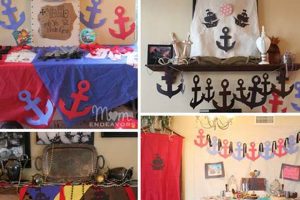Creating personalized adornments for the Islamic holy month allows for individual expression and fosters a deeper connection to the spiritual significance of Ramadan. Examples include handmade lanterns, paper stars, and creatively decorated banners featuring Islamic calligraphy or crescent moon motifs.
The practice of crafting decorations for Ramadan enhances the festive atmosphere within homes and communities, promoting a sense of unity and shared celebration. It also provides an opportunity to engage family members, particularly children, in meaningful activities that reinforce cultural traditions and religious values. Historically, home crafting has been a prevalent method of preparing for religious observances, offering a cost-effective and personalized approach to marking special occasions.
The following sections will explore various techniques, materials, and design ideas for producing bespoke adornments, catering to different skill levels and aesthetic preferences. Furthermore, guidance on incorporating sustainable practices into the crafting process will be provided, alongside considerations for ensuring safety during the creation and display of these decorative items.
DIY Ramadan Decorations
This section provides essential guidance for creating homemade Ramadan decorations, emphasizing safety, cost-effectiveness, and aesthetic appeal.
Tip 1: Material Selection: Opt for durable and non-toxic materials. Paper, felt, and natural fibers offer versatility and are suitable for various projects. Ensure paints and adhesives are child-safe, especially if children are involved in the crafting process.
Tip 2: Planning and Design: Before commencing a project, sketch designs and calculate material requirements. This minimizes waste and ensures a cohesive aesthetic throughout the decorated space. Consider the existing decor and choose a color palette that complements the surroundings.
Tip 3: Safety Precautions: When using sharp tools like scissors or craft knives, exercise caution. Supervise children closely and provide appropriate safety equipment. Avoid placing decorations near open flames or heat sources.
Tip 4: Incorporating Islamic Art: Utilize Islamic calligraphy, geometric patterns, and traditional motifs in the designs. Stencils, stamps, or freehand drawing can be employed to create visually appealing and culturally relevant decorations.
Tip 5: Repurposing Existing Materials: Reduce waste and save resources by repurposing existing materials. Empty jars can be transformed into lanterns, fabric scraps can be used for banners, and old cardboard boxes can be fashioned into decorative shapes.
Tip 6: Lighting Considerations: Incorporate appropriate lighting to enhance the ambiance of the decorations. Battery-operated LED lights are a safe and energy-efficient option for illuminating lanterns, garlands, or window displays. Avoid using traditional candles indoors due to fire hazards.
Tip 7: Storage and Maintenance: Plan for proper storage of the decorations after Ramadan. Store them in a dry, dust-free environment to prevent damage and ensure they can be reused in subsequent years. Periodically clean the decorations to maintain their appearance.
By implementing these tips, individuals can create visually appealing and meaningful decorations for Ramadan while prioritizing safety, sustainability, and cultural relevance.
The subsequent section will present innovative decoration ideas, catering to various skill levels and aesthetic preferences, providing inspiration for personalized Ramadan displays.
1. Material Sustainability
The integration of material sustainability within the context of handcrafted Ramadan decorations reflects a growing awareness of environmental responsibility. This approach prioritizes resource conservation and waste reduction, aligning festive traditions with ecological consciousness.
- Repurposing Textiles
The practice of repurposing existing textiles, such as old clothing, curtains, or bedsheets, reduces reliance on newly manufactured fabrics. These materials can be transformed into banners, cushion covers, or decorative wall hangings. Implementing this approach minimizes textile waste destined for landfills.
- Utilizing Recycled Paper and Cardboard
Recycled paper and cardboard provide versatile mediums for creating various decorations, including lanterns, stars, and decorative garlands. These materials can be sourced from discarded packaging or dedicated recycling programs, reducing the demand for virgin paper production and minimizing deforestation.
- Employing Natural and Biodegradable Materials
Natural materials like wood, bamboo, jute, and cotton offer sustainable alternatives to synthetic materials. These resources are renewable and biodegradable, reducing the environmental impact associated with disposal. They can be used to create ornaments, lanterns, or decorative accents that complement the festive ambiance.
- Minimizing Adhesive and Paint Usage
Reducing the use of adhesives and paints contributes to a more sustainable crafting process. Opting for natural adhesives, such as flour paste or water-based glues, minimizes the release of harmful chemicals into the environment. Similarly, using eco-friendly paints or natural dyes reduces the environmental footprint associated with decoration creation.
By embracing these facets of material sustainability, the creation of decorations for Ramadan becomes a conscious act of environmental stewardship. This approach aligns traditional celebrations with contemporary values, fostering a deeper connection between cultural practices and ecological responsibility, offering a pathway for environmentally conscious festivities.
2. Skill Level
Skill level is a determining factor in the successful execution of homemade Ramadan decorations. Inadequate skills may lead to frustration, substandard results, and ultimately, abandonment of projects. Conversely, accurate assessment of skills enables realistic project selection, increasing the likelihood of completion and satisfaction. For example, an individual with minimal crafting experience might begin with simple paper chain decorations, while someone proficient in sewing could create elaborate fabric banners with intricate appliqu work. This differentiation highlights the importance of matching project complexity to skill proficiency.
The choice of materials and techniques directly correlates with skill level. Novices benefit from readily available materials like construction paper, glue sticks, and pre-cut shapes, facilitating basic designs. Experienced crafters, however, can manipulate more complex materials such as wood, metal, or specialized fabrics, employing advanced techniques like calligraphy, woodworking, or intricate embroidery. Furthermore, online tutorials and craft guides often cater to specific skill levels, providing step-by-step instructions and templates that facilitate the crafting process and support skill development.
Ultimately, acknowledging skill level fosters a more enjoyable and productive crafting experience. Starting with manageable projects builds confidence and motivates further exploration of increasingly complex designs. Disregarding skill level may result in failed attempts, wasted materials, and a negative perception of the craft. Acknowledging and catering to skill level is therefore crucial for encouraging engagement with home decoration activities and ensuring a positive outcome.
3. Space Considerations
The efficacy of homemade Ramadan decorations is significantly influenced by pre-emptive assessment of spatial constraints. Decorations, irrespective of their aesthetic merit, can detract from an environment if their size, quantity, or placement disregards the available space. For instance, a sprawling banner, ideally suited for a large living room, would be disproportionately overwhelming in a confined apartment. Conversely, minimalistic decorations might be visually lost within a vast, sparsely furnished area. Accurate measurement and mapping of available surfaces are therefore critical prerequisites. The intended function of a space must also be considered; decorations should not impede routine activities, obstruct pathways, or compromise safety.
The impact of available space extends beyond mere physical dimensions. The color palette, lighting, and existing decor of a room influence the effectiveness of added decorations. A room dominated by dark colors might benefit from lighter, brighter decorations to provide visual contrast and prevent a somber ambiance. Conversely, a brightly lit room could accommodate bolder, more saturated colors without appearing overwhelming. The existing architectural features, such as windows, fireplaces, or shelving, offer potential integration points for decorations, minimizing their intrusion into the living area. The strategic placement of lighting, both natural and artificial, further enhances the visual impact of decorations. For example, carefully positioned spotlights can accentuate intricate details of handmade lanterns, while string lights can soften the overall ambiance.
In summary, the successful integration of adornments for Ramadan hinges upon a nuanced understanding of spatial dynamics. A thorough assessment of space limitations, existing dcor, and lighting conditions enables informed decisions regarding decoration size, style, and placement. This approach minimizes visual clutter, optimizes aesthetic appeal, and ensures that the decorations complement, rather than compromise, the functionality and comfort of the living environment, providing balanced Ramadan atmosphere.
4. Cultural Sensitivity
The creation of homemade Ramadan decorations carries a significant responsibility to respect cultural sensitivities. Misinterpretation or appropriation of Islamic symbols and traditions can cause offense and undermine the intended spirit of the holy month. Therefore, accurate representation and thoughtful adaptation are paramount. For example, utilizing calligraphy inappropriately, such as displaying religious verses out of context or in a disrespectful manner, is culturally insensitive. Similarly, incorporating elements from other religious or cultural traditions without understanding their origins and significance can be problematic. Cultural sensitivity, therefore, is an essential component of creating decorations that authentically reflect the values and traditions of Ramadan, enhancing rather than diminishing the festive atmosphere.
Practical application of cultural sensitivity in DIY Ramadan decorations involves diligent research and consultation. Before incorporating religious symbols, calligraphy, or traditional motifs, it is important to understand their meanings and appropriate contexts. Seeking guidance from knowledgeable individuals within the community can prevent unintentional misrepresentation. Furthermore, careful consideration should be given to the materials used. For instance, decorations intended for display in a mosque should adhere to religious guidelines regarding cleanliness and modesty. The placement of decorations within the home should also reflect respect for religious practices; avoiding locations where they might be stepped on or treated disrespectfully.
In conclusion, cultural sensitivity is not merely an optional consideration but an integral aspect of DIY Ramadan decorations. By prioritizing accurate representation, thoughtful adaptation, and respect for Islamic traditions, individuals can create decorations that genuinely reflect the spirit of the holy month. This approach avoids cultural appropriation and fosters a sense of unity and reverence, enhancing the overall Ramadan experience. The challenge lies in striking a balance between creative expression and cultural accuracy, requiring ongoing learning and sensitivity.
5. Time Investment
The creation of personalized Ramadan decorations necessitates a quantifiable allocation of time. This temporal investment spans various phases, from initial conceptualization and material acquisition to the actual crafting process and subsequent display. The magnitude of time required is directly proportional to the complexity of the designs and the scale of the decorating project. Simple decorations, such as paper lanterns or string lights, demand less time than intricate fabric banners adorned with calligraphy or hand-painted murals. Neglecting to adequately assess the time commitment can result in incomplete projects, rushed execution, and ultimately, diminished aesthetic outcomes, undermining the celebratory atmosphere intended for Ramadan.
The efficient management of time is therefore crucial. Procrastination often leads to frantic, last-minute efforts, compromising the quality and cultural sensitivity of the decorations. A structured approach, involving phased planning, scheduling dedicated crafting sessions, and delegating tasks among family members, optimizes the utilization of available time. For instance, pre-purchasing materials and preparing templates well in advance of Ramadan mitigates potential delays. Similarly, simplifying designs to align with available time constraints ensures timely completion without sacrificing aesthetic appeal. Consider the example of a community intending to decorate a local mosque; a collaborative effort with staggered shifts, each focusing on specific tasks, maximizes productivity and minimizes the burden on individual participants. This illustrates the practical application of time management principles in collective decoration endeavors.
In conclusion, acknowledging the significance of time investment is paramount to the successful undertaking of creating homemade Ramadan decorations. Prudent planning, efficient resource allocation, and realistic expectations regarding the scope of projects are essential. The temporal commitment should be viewed as an integral component of the creative process, rather than a mere logistical hurdle. Ultimately, a balanced approach to time management enhances both the quality of the decorations and the overall sense of accomplishment, contributing to a more meaningful and fulfilling Ramadan experience.
Frequently Asked Questions
This section addresses common inquiries regarding the creation and implementation of homemade Ramadan decorations, providing factual and practical guidance.
Question 1: What materials are most suitable for creating durable and aesthetically pleasing Ramadan decorations?
Durable and aesthetically pleasing adornments can be crafted from various materials. Consider using felt, known for its vibrant colors and resistance to fraying. Durable fabrics, such as cotton or linen, are suitable for banners and wall hangings. Paper, particularly cardstock, provides versatility for creating lanterns, stars, and other decorative elements. Utilizing a combination of these materials allows for both visual appeal and long-term usability.
Question 2: How can individuals ensure the safety of homemade Ramadan decorations, particularly when children are involved in the crafting process?
Safety is paramount, especially when children participate. Employ non-toxic materials, such as water-based paints and child-safe adhesives. Supervise children closely when using sharp tools like scissors or craft knives. Ensure that decorations are securely fastened and positioned away from potential hazards, such as open flames or electrical outlets. Battery-operated lights are recommended over traditional candles to mitigate fire risks.
Question 3: What are some effective strategies for incorporating Islamic art and calligraphy into DIY Ramadan decorations?
Effective strategies involve careful planning and respectful execution. Research traditional Islamic motifs and calligraphy styles to ensure accurate representation. Utilize stencils, stamps, or freehand drawing techniques to incorporate these elements into decorations. Consider using a consistent color palette to maintain visual harmony. When displaying calligraphy, ensure that the verses are presented in their proper context and with reverence.
Question 4: How can existing materials be repurposed to create cost-effective and environmentally friendly Ramadan decorations?
Repurposing existing materials reduces waste and minimizes expenses. Empty jars can be transformed into lanterns. Fabric scraps can be used to create banners, cushion covers, or patchwork decorations. Cardboard boxes can be fashioned into decorative shapes or used as templates. Old clothing can be cut and sewn into new decorative items. This approach not only reduces environmental impact but also adds a unique, personalized touch to the decorations.
Question 5: What are some common mistakes to avoid when creating DIY Ramadan decorations?
Common mistakes include inadequate planning, neglecting safety precautions, and cultural insensitivity. Avoid starting projects without a clear design and a list of necessary materials. Prioritize safety by using non-toxic materials and supervising children closely. Research and understand the meanings of Islamic symbols and traditions to avoid misrepresentation. Ensure that decorations are securely fastened to prevent accidents or damage.
Question 6: How should homemade Ramadan decorations be stored and maintained to ensure their longevity?
Proper storage and maintenance are essential for longevity. Store decorations in a dry, dust-free environment, such as a sealed container or storage box. Avoid exposing them to direct sunlight or extreme temperatures. Clean decorations periodically using a soft cloth or brush to remove dust and dirt. For delicate items, consider using a mild cleaning solution. By following these guidelines, individuals can preserve their homemade decorations and reuse them in subsequent years.
In summary, crafting aesthetically pleasing, secure, and culturally sensitive decorations requires careful preparation, responsible material usage, and adherence to safety guidelines. Following these suggestions ensures the creation of festive and meaningful Ramadan adornments.
The next section will provide specific project ideas, encompassing varying levels of complexity, intended to inspire and guide the creation process.
diy ramadan decorations
This exploration of homemade Ramadan decorations has underscored the significance of mindful creation. Material sustainability, skill level considerations, space assessment, cultural sensitivity, and time investment are all critical factors influencing the success and appropriateness of such endeavors. A balanced approach ensures that decorations enhance the festive spirit while respecting cultural values and environmental concerns.
The future of creating decorations for Ramadan lies in fostering a deeper connection between tradition and innovation. By embracing sustainable practices, promoting cultural accuracy, and encouraging intergenerational collaboration, individuals and communities can elevate the art of decoration to a meaningful expression of faith and unity, solidifying its importance in celebrating the holy month.







